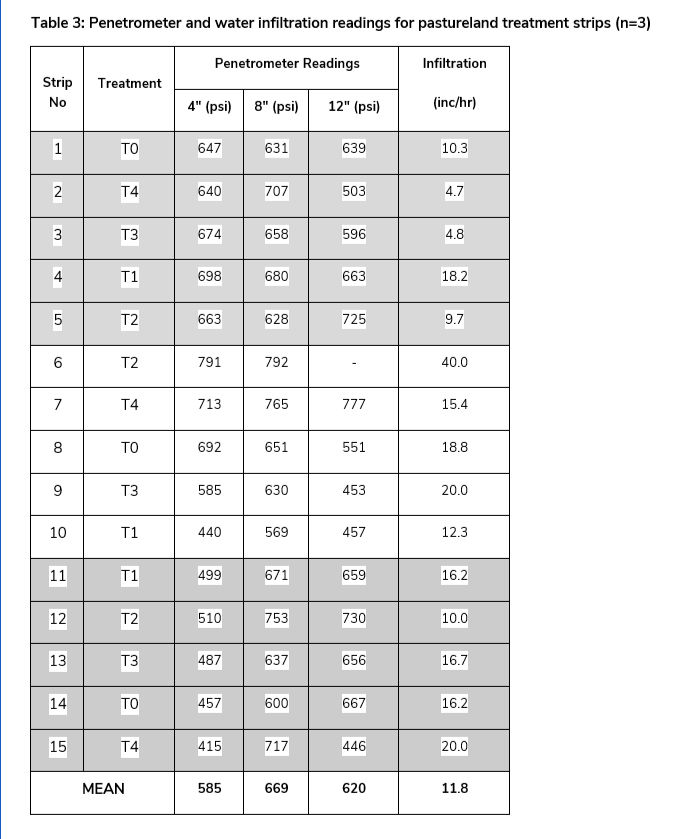Funded by Saddle Hills County
Objective
Terminating and re-establishing unproductive and depleted forage stands is leading livestock producers to look for alternative strategies or rejuvenation methods that are practicable, cost less, and will not take land out of production for more than one or more years. This project aims to investigate practical and cost-effective perennial rejuvenation methods on pasture land through reseeding without killing off existing forage stands.
Methods
The trial is taking place at the Saddle Hills County pasture land site along Hwy 719 in Pillsworth, AB, utilizing grass-legume pasture land that had been subjected to continuous grazing for over 10 years without any management improvements. Site soil information obtained before the implementation of treatments from the surface soil (0-6" soil depth): pH = 6.2, organic matter = 5.8, electrical conductivity = 0.2 dS/m, while the nutrient analysis of the soil gave N = 8 ppm, P = 9 ppm, K = 260 ppm and S = 1 ppm. Soil base saturation was 70.9% (Ca = 40.1%, Mg = 15.3%, Na 1.7%, K 5.9%). Figure 1 shows the weather (including precipitation and minimum and maximum air temperatures) recorded from seeding until early winter at the nearest AGCM Weather Station in Savanna, AB. Overall, low spring moisture conditions characterized 2023 after the initial 2" early spring moisture, additional moisture was obtained only about 6 weeks later in early July.

The following 5 treatments were set out each on 0.5-acre (60 ft x 363 ft) strips replicated thrice (see Figure 2):
Control or check strips – T0: no seeding at all – implemented on strips 1 and 8.
High stock density grazing (HSDG ) + Sod seeding – T1: implemented on June 08 to June 10 with 62 000 lbs/ac to create a mob grazing effect in Strips 4, 10 and 11. The yearlings were removed after they had grazed down the strip, and a legume mixture (see composition in Table 1) was then seeded into the 3 strips with a John Deere 107 Haybuster no-till drill by placing legume seeds at about 1/2".
Broadcast seeding + HSDG – T2: Legume mixture seeds were broadcasted onto strips 5, 6 and 12 with the no-till drill and later 62 000 lbs/ac was introduced into the strips to create a mob grazing effect and work seeds into soil. The treatment was also not grazed for the rest of the year following seeding and HSDG.
Pasture seeding during grazing – T3: 62 000 lbs/ac were equally partitioned into the 3 strips (strips 3, 9 and 13) for this treatment. The yearlings were provided with the legume mixture seeds in salt. Water was provided ad-lib. Yearlings were removed from strips after spending about 48 hours.
Broadcast fertilizer in spring – T4: Fertilizer blend was applied on strips 2, 7 and 15 according to soil test recommendations with a no-till drill at about 1/4". Nutrient recommendations for average (4.5 T/ac) forage yield: N=16 lbs/ac; P=35 lbs/ac; K=0 lbs/ac; S=15 lbs/ac.

Table 1: Composition of legume mixture used in seeding T1, T2 and T3
No |
Species/Varieties | Pastureland | |
% in stand | Seeding rate (lbs/ac) | ||
1 | Sainfoin variety AAC Mountainview | 34 | 16.5 |
2 | Cicer milkvetch variety Windsor | 33 | 4.5 |
3 | Birdsfoot trefoil variety Leo | 33 | 2.8 |
Total | 100 | 23.8 |
Baseline data (soil and forage components) was collected from 3 georeferenced points per strip in spring of 2023 before seeding of the strips. The botanical composition was determined by clipping fresh forage material, separating it into different functional groups (grasses, legumes, forbs, weeds), weighing and recording each group, drying them, and then reweighing to calculate the percentage of each functional group. Baseline forage yield (lbs/ac) and feed quality in a commercial laboratory were also determined. Surface soil water infiltration was measured using the single-ring infiltration method. Surface soil temperature and moisture were determined using the FieldScout TDR 250 probe at 0-6". Soil compaction was measured using the SpotOn Digital Compaction Meter (penetrometer) at 4, 8 and 12".
Baseline Results
Botanical Composition
The baseline botanical composition and forage dry matter yield of the strips taken at the beginning of the trial are given in Table 2. Across the pastureland, grass species formed about 40% of the stand and legumes just over 11%. Weeds such as dandelion and yarrow made up almost 50% of the botanical composition.
Forage Dry Matter Yield and Forage Quality
Forage dry matter yield from the strips averaged about 1000 lbs/ac. In general, the forage crude protein (CP) was above 11%, with an average of 14.4% (Table 2).
Soil Compaction and Water Infiltration
Results for soil compaction and water infiltration for treatment strips are given in Table 3. Penetrometer readings were all above 300 psi (an average of 585-669 psi from 4 to 12” soil depth) indicating that the pastureland was heavily compacted. Water infiltration was on average 12 in/hr.
Plant Emergence
Plant emergence was monitored after seeding and throughout the growing season, but it was very poor, with very few or no legume seedlings emerging.
Conclusion
Despite the high proportion of grass in the forage stand taken at baseline, the quality was quite high (> 14.0%). Compaction readings above 300 psi, particularly in the range of 415-792 psi, suggest that the pastureland has become significantly compacted, which can negatively impact soil health, root growth, and water infiltration and ecosystem sustainability. This ties up with the more than 10 years of continuous grazing history. The heavily compacted nature of the soil, low poor spring snow cover and the absence of moisture conditions after seeding most likely accounted for the poor emergence of the seeded perennial legumes. We will monitor the plant emergence establishment early next spring and take all necessary parameters to help determine the success of the different pasture rejuvenation methods.




Comments